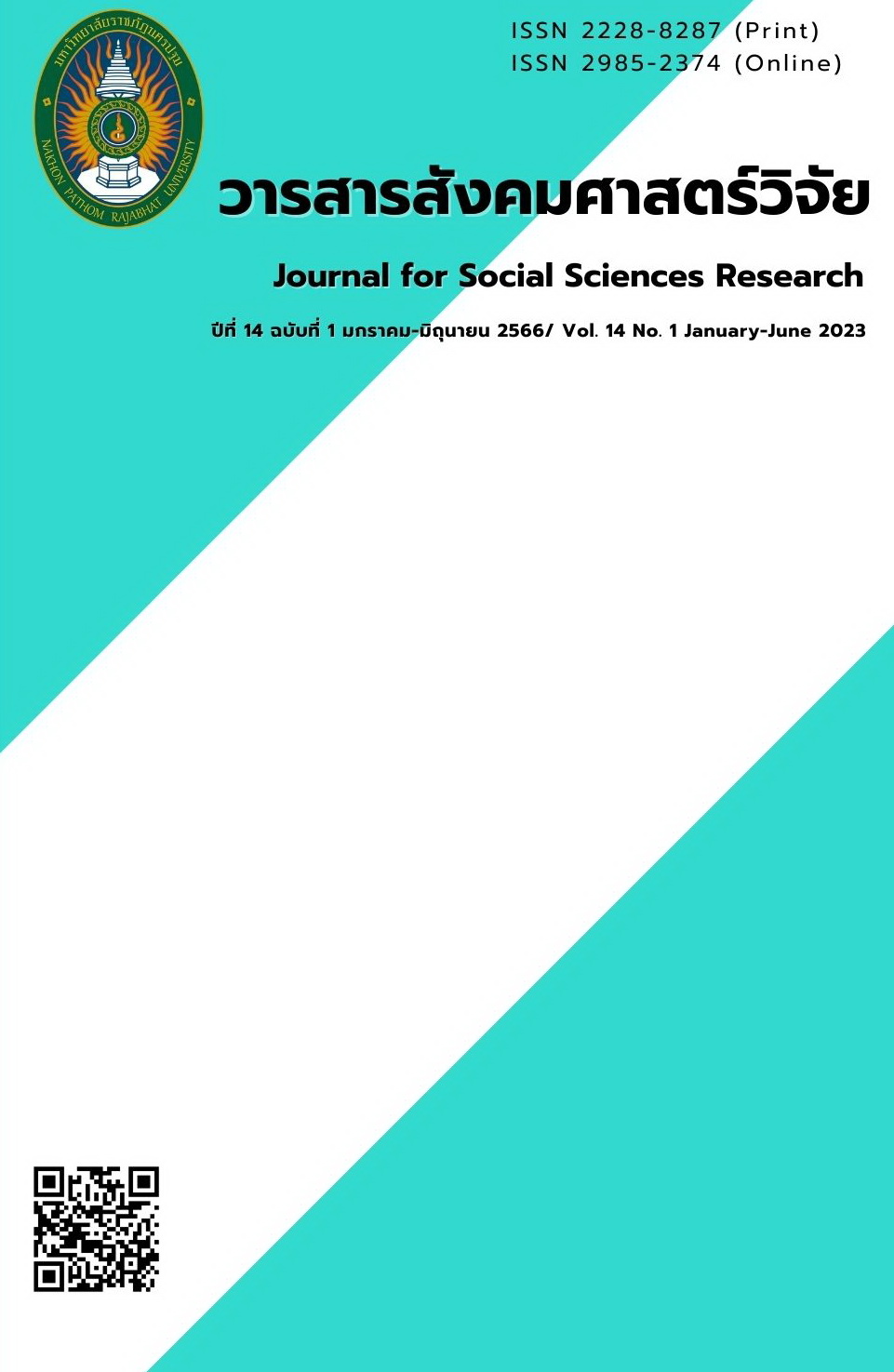THE DEVELOPMENT OF EXPLAINING PHENOMENA SCIENTIFICALLY COMPETENCE OF GRADE 5 STUDENTS THROUGH PHENOMENON-BASED LEARNING MANAGEMENT
Main Article Content
Abstract
The purposes of this research were to 1) compare the competence of grade 5 students in explaining phenomena scientifically before and after learning through phenomenon-based learning with the set criteria; 2) compare the science learning achievement of grade 5 students before and after learning through phenomenon-based learning with the set criteria; and 3) study students’ scientific attitudes toward learning through phenomenon-based learning. The research sample was 32 grade 5 students who studied in the second semester of the academic year 2021 at Wat Chong Phran School, Ratchaburi Province, derived from cluster sampling technique. The research instruments consisted of 1) lesson plans based on phenomenon-based learning; 2) a test for explaining phenomena scientifically competency; 3) an evaluation form for explaining phenomena scientifically tasks; 4) a science learning achievement test; and 5) an evaluation form for students’ scientific attitude. The data were analyzed with mean, standard deviation, and t-test.
The findings of this research were as follows: 1) the grade 5 students’ competence in explaining phenomena scientifically after learning through phenomenon-based learning was higher than before and higher than the set criteria of 70% with statistical significance at .05 level. 2) The science learning achievement of grade 5 students after learning through phenomenon-based learning was higher than before and higher than the set criteria of 70% with statistical significance at .05 level. 3) The grade 5 students' scientific attitude after learning through phenomenon-based learning was at a very good level.
Article Details

This work is licensed under a Creative Commons Attribution-NonCommercial-NoDerivatives 4.0 International License.
บทความที่ได้รับการตีพิมพ์เป็นลิขสิทธิ์ของมหาวิทยาลัยราชภัฏนครปฐม
เนื้อหาของแต่ละบทความเป็นทัศนะของผู้เขียน ซึ่งที่ปรึกษา บรรณาธิการ กองบรรณาธิการ และคณะกรรมการบริหารวารสารไม่จำเป็นต้องเห็นด้วย หรือร่วมรับผิดชอบใดๆ
References
ชนิฐฆ์ศรา เทพจันตา. (2556). การจัดกิจกรรมการเรียนรู้โดยใช้ข่าวเป็นสื่อเพื่อพัฒนาสมรรถนะการอธิบายปรากฏการณ์ในเชิงวิทยาศาสตร์และสมรรถนะการใช้ประจักษ์พยานทางวิทยาศาสตร์ เรื่องโมเมนตัม สำหรับนักเรียนชั้นมัธยมศึกษาปีที่ 4. วิทยานิพนธ์การศึกษามหาบัณฑิต สาขาวิชาวิทยาศาสตร์ศึกษา บัณฑิตวิทยาลัย มหาวิทยาลัยนเรศวร.
ประวิตร ชูศิลป์. (2542). เจตคติทางวิทยาศาสตร์ (scientific attitude) กับจุดมุ่งหมายของการสอนวิทยาศาสตร์. ลพบุรี: คณะวิทยาศาสตร์ สถาบันราชภัฏพิบูลสงคราม.
พงศธร มหาวิจิตร. (2560). นวัตกรรมการเรียนรู้จากฟินแลนด์. นิตยสาร สสวท, 46 (3), 40-45.
โรงเรียนวัดช่องพราน. (2559). รายงานผลการพัฒนาคุณภาพผู้เรียน. ราชบุรี: โรงเรียนวัดช่องพราน.
โรงเรียนวัดช่องพราน. (2560). รายงานผลการพัฒนาคุณภาพผู้เรียน. ราชบุรี: โรงเรียนวัดช่องพราน.
โรงเรียนวัดช่องพราน. (2561). รายงานผลการพัฒนาคุณภาพผู้เรียน. ราชบุรี: โรงเรียนวัดช่องพราน.
โรงเรียนวัดช่องพราน. (2562). รายงานผลการพัฒนาคุณภาพผู้เรียน. ราชบุรี: โรงเรียนวัดช่องพราน.
สถาบันส่งเสริมการสอนวิทยาศาสตร์และเทคโนโลยี. (2546). คู่มือการวัดผลประเมินผลผลวิทยาศาสตร์. กรุงเทพฯ: สถาบันส่งเสริมการสอนวิทยาศาสตร์และเทคโนโลยี.
สถาบันส่งเสริมการสอนวิทยาศาสตร์และเทคโนโลยี. (2554). ผลการประเมิน PISA 2009 การอ่าน คณิตศาสตร์ และวิทยาศาสตร์. กรุงเทพฯ: สถาบันส่งเสริมการสอนวิทยาศาสตร์และเทคโนโลยี.
สถาบันส่งเสริมการสอนวิทยาศาสตร์และเทคโนโลยี. (2563). แผนปฏิบัติการเชิงกลยุทธ์ ประจำปีงบประมาณ พ.ศ. 2562-2565. กรุงเทพฯ: สถาบันส่งเสริมการสอนวิทยาศาสตร์และเทคโนโลยี.
สถาบันส่งเสริมการสอนวิทยาศาสตร์และเทคโนโลยี. (2564 ก). เอกสารประกอบการอบรม การจัดการเรียนรู้ฐานสมรรถนะทางวิทยาศาสตร์. กรุงเทพฯ: สถาบันส่งเสริมการสอนวิทยาศาสตร์และเทคโนโลยี.
สถาบันส่งเสริมการสอนวิทยาศาสตร์และเทคโนโลยี. (2564 ข). ผลการประเมิน PISA 2018 การอ่าน คณิตศาสตร์ และวิทยาศาสตร์. กรุงเทพฯ: สถาบันส่งเสริมการสอนวิทยาศาสตร์และเทคโนโลยี.
Anderson, L. et al. (2001). A taxonomy for learning, teaching, and assessing (Abridged Edition). New York: Longman.
Daehler, K. R. & Folsom, J. (2016). Making sense of science: Phenomena-based learning. Retrieved 17 October 2020, from https://wemss.weebly.com/uploads/8/6/4/9/ 8649828/mss_pbl.pdf.
Islakhiyah, K., Sutopo, S. & Yulianti, L. (2017). Scientific explanation of light through phenomenon-based learning on junior high school student. Advances in Social Science, Education and Humanities Research, 17 (218), 173-185.
Likert, R. (1976). New way management conflict. New York: McGraw-Hill.
OECD. (2019 ). PISA 2018 assessment and analytical framework. Retrieved 8 July 2021, from https://www.oecd-ilibrary.org/docserver/f30da688-en.pdf?expires=1627885756&id
Partnership for 21st Century Skills. (2009). Framework definitions. Retrieved 9 January 2021, from http://www.p21.org/documents/P21_Framework_Definitions.pdf
Rotherham, A. J. & Willingham, D. (2009). 21st century skills: The challenges ahead. Educational Leadership, 67 (1), 16-21.
Silander, P. (2015). Phenomenon-based learning. Retrieved 5 May 2017, from http://www.phenomenaleducation.info/phenomenon-based-learning.


